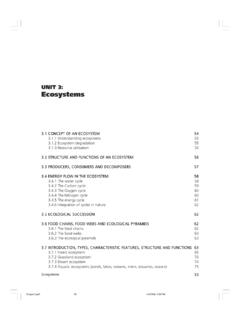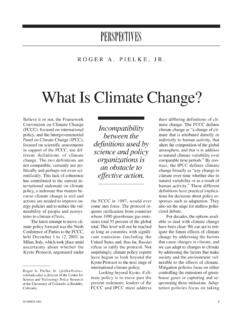Transcription of The Colorado River Basin: An Overview
1 The Colorado River basin : An OverviewBy the State of the Rockies Project 2011-12 Research TeamBrendan BoeppleThe 2012 Colorado College State of the Rockies Report CardThe Colorado River basin : Agenda for Use, Restoration, and Sustainability for the Next GenerationThe 2012 State of the Rockies Report Card basin Overview 25 The Colorado River basin The Colorado River is often referred to as the life-blood of the American Southwest. This legendary River begins both as snowmelt at its headwaters in mountainous northern Colorado , and as the origin of the Green River in the Wind River Range of Wyoming; then winds through seven states and approximately 1,400 miles of stunningly diverse ecosys -tems before it reaches the below-sea level desert expanses of Mexico. Thirty million Southwesterners, 20 Native American tribes, and Northern Mexico, as well as numerous species of flora and fauna, rely on its waters for their livelihoods and day-to-day The River supports major cities such as Denver, Los Angeles, Phoenix, and Las Vegas, through a carefully regulated dam, canal, and pipeline system.
2 However, municipal uses pale in comparison to the nearly three mil-lion acres of farmland that utilize close to 80% of the River s annual Yet the flow is not what it once was, as drought, over-apportionment, and ever-expanding urban development have depleted the supplies of this cherished resource to the point where it no longer reaches the Gulf of Mexico. Its future has become increasingly contentious and uncertain. Parts of the seven states of Wyoming, Colorado , Utah, New Mexico, Arizona, California, and Nevada form the portion of the 243,000 square-mile Colorado River basin (8% of the contiguous )3, with 2% of this area located internationally in Mexico s Sonoran Desert. The 1922 Colo-rado River Compact, created by these seven states, separated the basin into an upper and lower region with Lee s Ferry just below Glen Canyon Dam as the point of division. Wyoming, Colorado , Utah, New Mexico, and the northern portion of Arizona make up the 109,800 square-mile Upper basin , while Arizona, California, and Nevada constitute the Lower basin region as seen in Figure Powell Expedition: John Wesley Powell makes the rst trip down the Colorado River .
3 Historical Timeline of the Colorado River with Annual Flows (MAF)Note: e ows depicted in this graph from 1869-1905 are reconstructed estimates from tree-ring data from Meko et al. (2007)*, from 1906-2008 are o cial calculated ows of the River from the Bureau of Reclamation, and from 2009-2011 are estimated by Je Lukas from Reclamation preliminary gaged (unregulated) Lake Powell water year in ows (2009: 88% of average; 2010: 73%, 2011: 139%) using a regression model relating the unregulated in ows and natural ows for 1999-2008.*Meko, , Woodhouse, , Baisan, , Knight, T., Lukas, , Hughes, , and Salzer, 2007. Medieval Drought in the Upper Colorado River basin . Geophysical Research Letters 34, 1: Map of the Colorado River basin divided into Upper and Lower basin -Upper BasinLower BasinUSAMEXICOU pper Colorado BasinLower Colorado BasinWyomingColoradoNew MexicoArizonaUtahNevadaCaliforniaTexasCh ihuahuaSonoraBaja basin Overview The 2012 State of the Rockies Report Card26 Laws and Apportionment The Colorado River basin is ruled by a compilation of decrees, rights, court decisions, and laws that together are referred to as the Law of the River .
4 The keystone of these commandments is the 1922 Colorado River Compact, an interstate agreement created by the seven basin states with provisions for general water allotments, including a mil-lion acre feet (maf) annual delivery requirement from the Up-per to the Lower The 1928 Boulder Canyon Project Act (along with the 1963 Supreme Court decision in Arizona v. California) divided the Lower basin s maf with an extra one maf in wet years between Arizona, California, and The 1948 Upper Colorado River basin Com-pact divided the Upper basin s average allotment of maf among the five States allocate their individual shares of the waters of the Colorado River and ultimately have the highest authority after the Secretary of the Interior. The Sec-retary of the Interior is often called the water master of the Colorado River , as he/she has the final ruling on nearly every conflict, be it the definition of beneficial use or the creation of shortage The Colorado River Compact of 1922, which set the annual average as maf and divided this amount up between the basin states (as seen in Figure 2), was created in the wettest recorded ten-year period of the last 100 years.
5 This was from 1914-1923, in which the annual average was maf. In 2000, the Colorado River basin entered a period of drought, accompanied by decreased precipitation and increased average temperatures, and continues today. Flows from 2001 to 2009 averaged around maf at Lee s Ferry: roughly a 4-5 maf reduction from the 16-17 maf assumed average flows from the 2: Colorado River Water Apportionments by StateUpper mafNew mafLower mafTotal 7 mafTotal for Entire maf Major tributaries of the Upper basin include the Green, San Juan, Escalante, Gunnison, and Dolores Rivers, and the Lower basin is fed largely by the Paria, Virgin, Little Colorado , Bill Williams, and Gila The basin , its water apportionment, and the protection of its environmental resources have long formed a complex combination of states rights, federal agency involvement, and Native American tribal water rights, and as such, has often been a ground for both conflict and Reclamation Act: eodore Roosevelt signs Reclamation Act which leads to research on impact of irrigation and construction on the River .
6 It also created the Bureau of Salton Sea Created: e Colorado River breaks into the Imperial Valley, causing extensive damage and creating the Salton Winters v. United States: Supreme Court case establishing Indian reserved water 2012 State of the Rockies Report Card basin Overview 27 Federal, State, Native American, and Mexican InvolvementNative American involvement and tribal water rights There are 34 established Native American reserva-tions within the Reservations on paper have federally reserved implied water rights, but many reservations inabil-ity to put their newly appropriated waters to beneficial use has resulted in subsequent conflicts between tribes and other stakeholders in the basin . The granting of new water rights to the tribes has led to a forced reduction of use by 13 In addition to these tribal lands, large areas of land in the basin are also owned by the federal government as seen in Figure s Role In 1944, a treaty facilitated by the International Boundary Water Commission (IBWC) was signed granting Mexico maf annually.
7 However, no water quality standards were established and as the River became increasingly devel-oped, deliveries to Mexico were often diverted and/or had a near-toxic salinity level. In 1973, IBWC Minute Number 242 was signed mandating the to adopt measures to reduce the salinity of those waters delivered to Mexico. Issues such as the lack of water reaching the Colorado River Delta, the lining of the All-American Canal, and maintaining the Ci nega de Santa Clara continue to affect relations. -Federal LandsBureau of Land ManagementBureau of ReclamationDept. of DefenseForest ServiceFish & Wildlife ServiceNational Park ServiceUpper BasinLower BasinUSAMEXICOF igure 3: Federal Land Ownership in the Colorado River basin Brendan Boepple, The dry Colorado River bed near San Luis Rio Colorado , Colorado River Compact: Organized the Upper and Lower Colorado River Basins and apportions of Colorado River water per year each to the upper and lower Weymouth Report: Recommends Boulder Canyon project Boulder Canyon Project Act: Authorized construction of Hoover Dam and use of water stored in dam in Arizona, California, and Nevada under contract with (division of Lower basin water disputed until Arizona v.)
8 California).1936- Hoover Dam completed: Lake Mead is Parker Dam completed: Lake Havasu is : National Land Atlas Federal and Indian Lands Areas basin Overview The 2012 State of the Rockies Report Card28 Uses of the Colorado River Nearly all water in the Colorado River has been put to beneficial use both inside and outside of the basin . Hu-man beneficial use does not generally include instream flows (leaving water in the River for environmental purposes), and has largely meant use for agriculture, municipal and indus-trial purposes, and recreation. Forty-five percent of Colorado River water is diverted out of the basin for both agricultural, municipal, and industrial use; many cities such as Denver, Los Angeles, and Salt Lake City already rely heavily on trans- basin diversions which disrupt surrounding Figure 4 illustrates the low and high flow of the River with many of these Use Areas in the West that use Colorado River water have proven to be agriculturally productive despite the arid climate, with a diverse crop yield that includes alfalfa, hay, wheat, cot-ton, and lettuce.
9 Today, 78% of the water from the Colorado River is used for agricultural purposes. The concentrations of some of these minerals are now sufficiently high in some areas of the basin as to threaten the viability of agriculture there, as well as causing local water quality Use The natural diversity and picturesque backdrop throughout the Colorado River basin make it a popular desti-nation for many outdoor recreation activities such as fishing, skiing, boating, camping, hiking, wildlife-viewing, hunting, and swimming. The multi-billion dollar industry relies on continued precipitation and flows in order to attract the tens of millions of people each year who support local economies and businesses. Figure 4: Inflows and Outflows of the Colorado Colorado River Aqueduct All-American Canal Mexican Water Treaty: Guarantees maf of the River s annual ow to Mexico except in times of extraordinary drought .1948- Upper Colorado River basin Compact: Apportions a percentage of the available maf among Colorado ( ), New Mexico ( ), Utah(23%), Wyoming(14%) and the portion of Arizona within the Upper basin (50,000af/yr).
10 1950- Morelos Dam McCarran Amendment: Allows to participate in state general adjudication processes to establish federal water Colorado River Storage Project: Authorized construction of Glen Canyon, Flaming Gorge, Navajo and Curecanti dams for River regulation, power production and irrigation in the Upper Arizona v. California: Supreme Court con rmed that Congress had allocated Colorado River water in the Boulder Canyon Project Act, giving maf to California, maf to Arizona, and maf to Nevada; also decided that Indian reservations along the Colorado River had rights to use about maf from the River , the uses to be counted against the shares allocated to the states in which the reservations were located. Determined states have the exclusive rights to those tributaries originating within their boundaries, but designated the Secretary of the Interior water master for the lower main stem, with the power to allocate water in times of MexicoArizonaColorado-Out Flow Average, 2003-2007 Million-Acre Feet per - - 11 - - FlowHigh FlowAreas that Receive WaterUpper BasinLower BasinUSAMEXICOS ource: Jonathan Waterman, Samuel Velasco, and Robert E.








